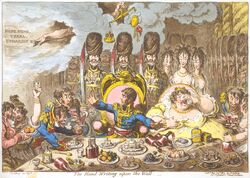"The writing on the wall" (or sometimes "handwriting on the wall"), an idiom, is a portent of doom or misfortune. It originates in the Biblical book of Daniel—where supernatural writing foretells the demise of the Babylonian Empire. The phrase is widely used in language and literature.
In the Book of Daniel[]
In the book of Daniel,[1] King Belshazzar of Babylon during a drunken feast takes sacred golden and silver vessels, which had been removed from Solomon's Temple in Jerusalem by his predecessor Nebuchadnezzar. Using these holy items, the King and his court praise 'the gods of gold and silver, brass, iron, wood, and stone'. Immediately, the disembodied fingers of a human hand appear and write on the wall of the royal palace the words מנא ,מנא, תקל, ופרסין (Mene, Mene, Tekel u-Pharsin). Although usually left untranslated in English translations of Daniel, these words are known Aramaic names of measures of currency: MENE, a mina, TEKEL, a spelling of shekel, PERES, half a mina.[2]
Despite various inducements, none of the royal magicians or advisors can interpret the omen. (Jewish commentators offer several explanations as to why they might even have been unable to read the words, which were in their own language: that they were written vertically, for example, or in the Old Hebrew alphabet.) The King sends for Daniel, an exiled Jew taken from Jerusalem, who had served in high office under Nebuchadnezzar. Rejecting offers of reward, Daniel warns the King of the folly of his arrogant blasphemy before reading the text. The meaning that Daniel decrypts from these words is based on passive verbs corresponding to the measure names.
And this is the writing that was inscribed: MENE, MENE, TEKEL, and PARSIN. This is the interpretation of the matter: MENE, God has numbered the days of your kingdom and brought it to an end; TEKEL, you have been weighed on the scales and found wanting; PERES, your kingdom is divided and given to the Medes and Persians.[3] - —Daniel 5:25-28
That very night King Belshazzar is slain, and Darius the Mede becomes King.
Later usage[]

In The Hand-Writing upon the Wall (1803), James Gillray caricatured Napoleon in the role of Belshazzar.
The phrase the writing on the wall has come to signify a portent of doom—or the end of an organization or activity. To attribute to someone the ability to "read the writing on the wall" has come to signify the ability to foresee (not necessarily supernaturally) an inevitable decline and end.
The Oxford English Dictionary entry on writing has literary references to this phrase in English, including the following verse from the poem "The Run Upon The Bankers" by Jonathan Swift
A baited banker thus desponds,
From his own hand foresees his fall,
They have his soul, who have his bonds;
'Tis like the writing on the wall.
In John Cheever's short story "Mene, Mene, Tekel, Upharsin," the narrator encounters graffiti (one example running several pages) in various public washrooms.
See also[]
- The Book of Daniel
- Daniel 2 - Image prophecy
- Daniel 3 - Fiery furnace
- Daniel 7 - Prophecy of the beasts
- Daniel 8 - Prophecy of goat/ram/horn
- Daniel 9 - Seventy-week prophecy
- Daniel 11 - Prophecy of Kings
- Belshazzar's Feast, for works of art inspired by this passage.
References[]
- ↑ Daniel 5:1–31
- ↑ note to Daniel 5:25, The New American Bible, November 11, 2002, United States Conference of Catholic Bishops
- ↑ "Bible, Revised Standard Version". http://quod.lib.umich.edu/cgi/r/rsv/rsv-idx?type=DIV1&byte=3332140. Retrieved 2009-01-08.
Further reading[]
- Towner, W. S. (1984), Daniel: Interpretation Commentary, Atlanta: John Knox Press, ISBN 0804231222.
- Goldingay, J. E. (1989), Daniel: Word Biblical Commentary, Dallas: Word Books, ISBN 0849902290.
- The New Oxford Annotated Bible, Revised Standard Version, Oxford University Press, 1972.
External links[]
| This page uses content from the English Wikipedia. The original article was at The writing on the wall. The list of authors can be seen in the page history. |